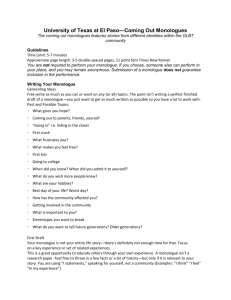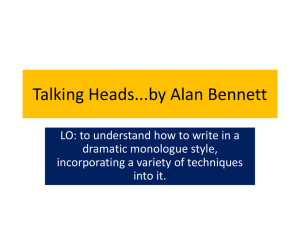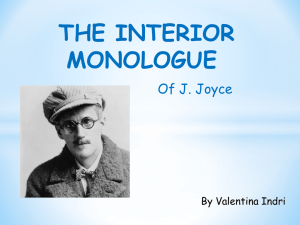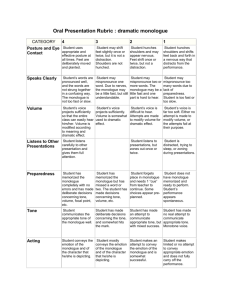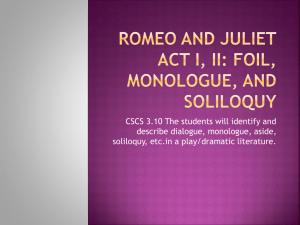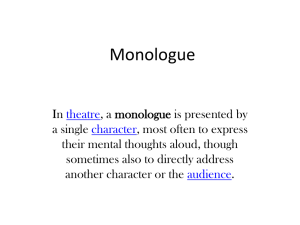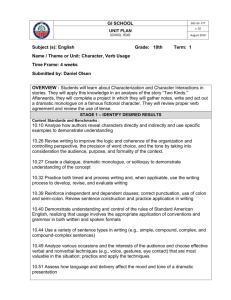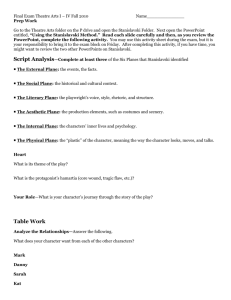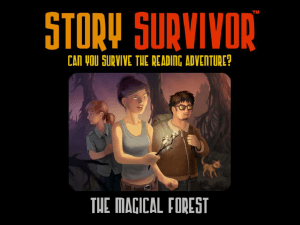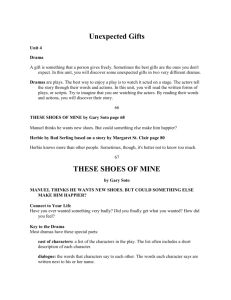Oral Text Production #1
advertisement
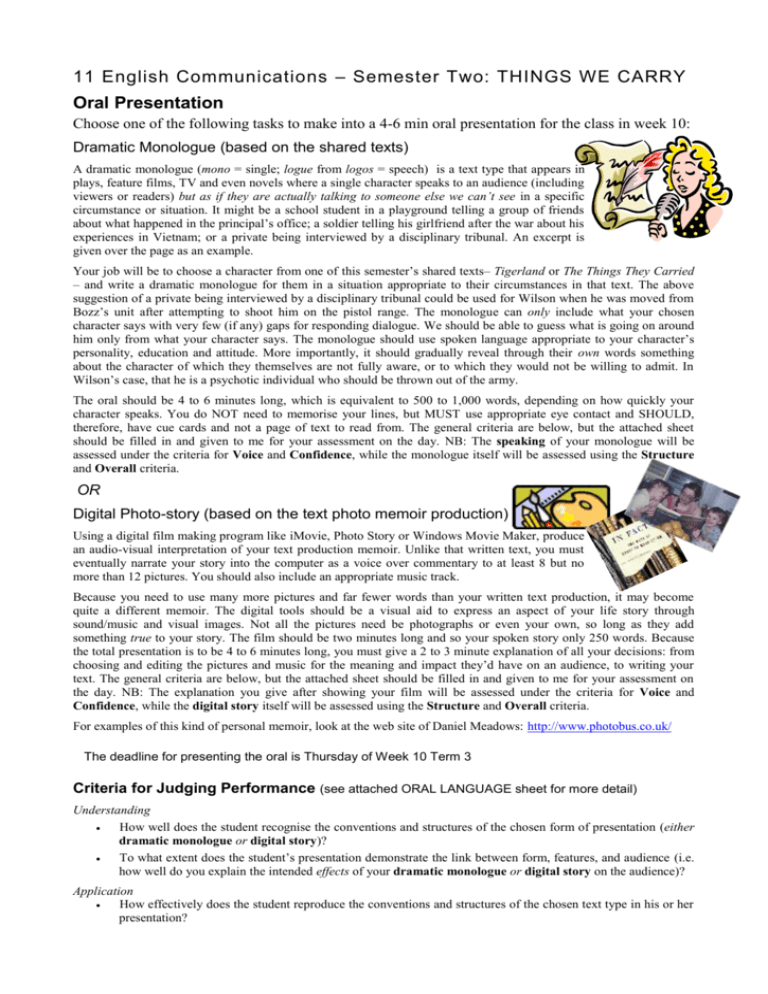
11 English Communications – Semester Two: THINGS WE CARRY Oral Presentation Choose one of the following tasks to make into a 4-6 min oral presentation for the class in week 10: Dramatic Monologue (based on the shared texts) A dramatic monologue (mono = single; logue from logos = speech) is a text type that appears in plays, feature films, TV and even novels where a single character speaks to an audience (including viewers or readers) but as if they are actually talking to someone else we can’t see in a specific circumstance or situation. It might be a school student in a playground telling a group of friends about what happened in the principal’s office; a soldier telling his girlfriend after the war about his experiences in Vietnam; or a private being interviewed by a disciplinary tribunal. An excerpt is given over the page as an example. Your job will be to choose a character from one of this semester’s shared texts– Tigerland or The Things They Carried – and write a dramatic monologue for them in a situation appropriate to their circumstances in that text. The above suggestion of a private being interviewed by a disciplinary tribunal could be used for Wilson when he was moved from Bozz’s unit after attempting to shoot him on the pistol range. The monologue can only include what your chosen character says with very few (if any) gaps for responding dialogue. We should be able to guess what is going on around him only from what your character says. The monologue should use spoken language appropriate to your character’s personality, education and attitude. More importantly, it should gradually reveal through their own words something about the character of which they themselves are not fully aware, or to which they would not be willing to admit. In Wilson’s case, that he is a psychotic individual who should be thrown out of the army. The oral should be 4 to 6 minutes long, which is equivalent to 500 to 1,000 words, depending on how quickly your character speaks. You do NOT need to memorise your lines, but MUST use appropriate eye contact and SHOULD, therefore, have cue cards and not a page of text to read from. The general criteria are below, but the attached sheet should be filled in and given to me for your assessment on the day. NB: The speaking of your monologue will be assessed under the criteria for Voice and Confidence, while the monologue itself will be assessed using the Structure and Overall criteria. OR Digital Photo-story (based on the text photo memoir production) Using a digital film making program like iMovie, Photo Story or Windows Movie Maker, produce an audio-visual interpretation of your text production memoir. Unlike that written text, you must eventually narrate your story into the computer as a voice over commentary to at least 8 but no more than 12 pictures. You should also include an appropriate music track. Because you need to use many more pictures and far fewer words than your written text production, it may become quite a different memoir. The digital tools should be a visual aid to express an aspect of your life story through sound/music and visual images. Not all the pictures need be photographs or even your own, so long as they add something true to your story. The film should be two minutes long and so your spoken story only 250 words. Because the total presentation is to be 4 to 6 minutes long, you must give a 2 to 3 minute explanation of all your decisions: from choosing and editing the pictures and music for the meaning and impact they’d have on an audience, to writing your text. The general criteria are below, but the attached sheet should be filled in and given to me for your assessment on the day. NB: The explanation you give after showing your film will be assessed under the criteria for Voice and Confidence, while the digital story itself will be assessed using the Structure and Overall criteria. For examples of this kind of personal memoir, look at the web site of Daniel Meadows: http://www.photobus.co.uk/ The deadline for presenting the oral is Thursday of Week 10 Term 3 Criteria for Judging Performance (see attached ORAL LANGUAGE sheet for more detail) Understanding How well does the student recognise the conventions and structures of the chosen form of presentation (either dramatic monologue or digital story)? To what extent does the student’s presentation demonstrate the link between form, features, and audience (i.e. how well do you explain the intended effects of your dramatic monologue or digital story on the audience)? Application How effectively does the student reproduce the conventions and structures of the chosen text type in his or her presentation? Two extracts from dramatic monologues for modelling your own writing An extract from “The Drover’s Wife” by Murray Bail (1975) In this monologue, an Adelaide dentist has just come across a painting of his wife who had left him many years earlier. The ‘situation’ is that he is speaking to an exhibition curator in the art gallery in which the painting has been hung. 457 words There has perhaps been a mistake - but of no great importance - made in the denomination of this picture. The woman depicted is not “The Drover’s Wife”. She is my wife. We have not seen each other now ... it must be getting on thirty years. This portrait was painted shortly after she left – and had joined him. Notice she has very conveniently hidden her wedding hand. It is a canvas 20 X 24 inches, signed l /r ‘Russell Drysdale’. I say “shortly after” because she has our small suitcase – Drysdale has made it look like a shopping bag – and she is wearing the sandshoes she normally wore to the beach. Besides, it is dated 1945. It is Hazel alright. How much can you tell by a face? That a woman has left a husband and two children? Here, I think the artist has fallen down (though how was he to know?). He has Hazel with a resigned helpless expression – as if it was all my fault. Or, as if she had been a country woman all her ruddy life. Otherwise the likeness is fair enough. Hazel was large-boned. Our last argument I remember concerned her weight. She weighed – I have the figures – 12 stone 4 ounces. And she wasn’t exactly tall. I see that she put it back on almost immediately. It doesn’t take long. See her legs. She had a small, pretty face, I’ll give her that. I was always surprised by her eyes. How solemn they were. The painting shows that. Overall, a gentle face, one that other women liked. How long it must have lasted up in the drought conditions is anybody’s guess. A drover! Why a drover? It has come as a shock to me. “I am just going round the corner,” she wrote, characteristically. It was a piece of butcher’s paper left on the table. Then, and this sounded odd at the time; “Your tea’s in the oven. Don’t give Trev any carrots.” Now that sounded as if she wouldn’t be back, but after puzzling over it, I dismissed it. And I think that is what hurt me most. No “Dear” at the top, not even “Gordon”. No “love” at the bottom. Hazel left without so much as a goodbye. We could have talked it over. Adelaide is a small town. People soon got to know. They ... shied away. I was left alone to bring up Trevor and Kay. It took a long time - years - before, if asked, I could say; “She vamoosed. I haven’t got a clue to where.” Fancy coming across her in a painting, one reproduced in colour at that. I suppose in a way that makes Hazel famous. An extract from “Herbie” by Archie Weller (1975) In this monologue, a white boy from rural Western Australian reveals the racist bullying and violence that lead to the death of an Aboriginal boy in his school. The ‘situation’ is less clear, but he is probably confessing his part in Herbie’s death to some outsider, probably an acquaintance who lives in Perth. What is clear, apart from his use of rural white Australian slang, is his matter-of-fact acceptance of racist attitudes alongside a gradual awareness of his own guilt. 300 words There weren’t many Abos in our town; only the Corrigans and Herbie’s lot and, as the Corrigans and Herbie’s cousins were all grown up, Herbie was the only boong to go to our school. Perhaps this is why we all taunted and teased him, because he was different and us kids don’t like anything different. Since this is all about Herbie, I reckon I’d better have a go at describing him. But this is real hard, because he was all thought: I mean, like, he’d look at you with those big, brown scowling eyes and he’d look right into you, so anything you knew, he’d know. Those eyes seemed to take up almost all of his face, then the nose, flat as a board and all nostrils, took up the rest. You never noticed his mouth, because he rarely spoke and never smiled. He’d flit around the shadows like a crow – he was black as one, too. His legs were long and thin like a crane’s and his arms were long and skinny. His hands were abnormally big and his fingers long, so he was clumsy. He wasn’t big and he wasn’t strong, Herbie, and they reckoned that was because he never got enough to eat. But he was an Abo, and they never do. Whenever he came to school, he’d only sleep, so it weren’t really much good him coming. And us blokes used to smash him up, every break. Once the three Morgan boys locked him in the boys’ dunny and left him there all day. The next day he was caned for six for wagging school, but he never told. That was the good thing about Herbie: no matter what happened to him, he never told – not even on me, and I was one of the worst. ORAL LANGUAGE: INDIVIDUAL PRESENTATION Student __________________________________________________ Date_____________________ Topic _____________________________________________________________________________ Type of activity _____________________________________________________________________ Audiovisual aids and/or other aids used __________________________________________________ CRITERIA (Select or add to suit task) Task Description: Purpose, Context and Situation / Audience. Voice Excellent Satisfactory Poor • Clear and audible • Fluent • Effective emphasis/tone Confidence • Appropriate eye contact • Appropriate stance/posture • Well-paced • Appropriate use of movement/gestures Student’s Self-assessment/Reflection • Effective coping with mistakes Structure • Effective opening • Logical progression • Effective conclusion • Within time-limit Teacher’s Descriptive Report Overall • Preparation and planning • Effective use of notes/aids • Knowledge of topic • Effective interpretation • Interest in or enthusiasm for subject • Appropriate choice of content for audience Teacher’s Assessment Other criteria ______________________ Teacher’s Signature: ______________________ ______________________________________
